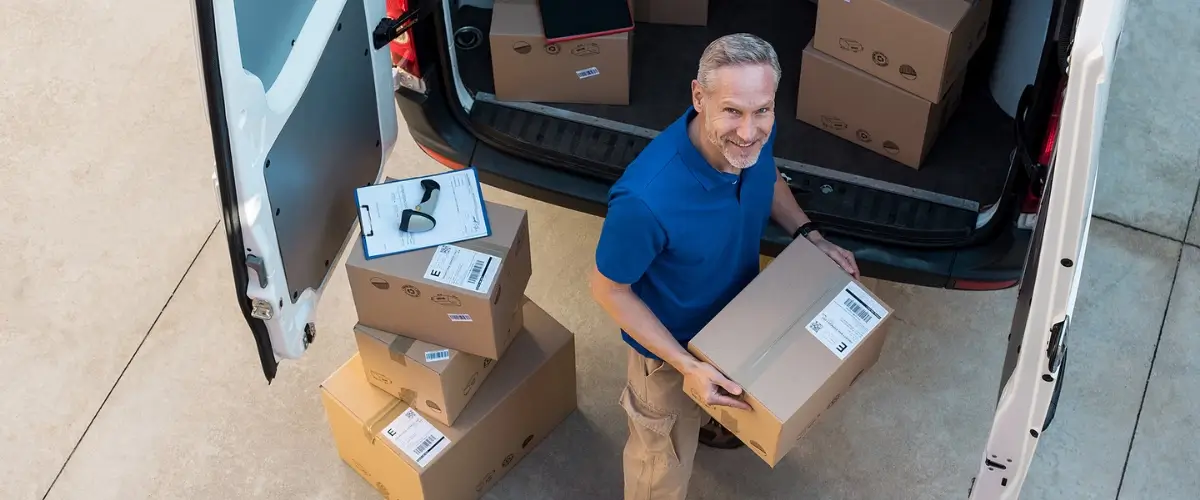Fast Shipping & Overnight Shipping for Companies of Any Size
If you ask the average person about fast shipping or expedited shipping, they might imagine a big brown van speeding along the road. More informed people know, however, that it takes a high level of logistics coordination to deliver packages on the same day or overnight.
For ecommerce and supply chain stakeholders, the interest is even greater. Consider these stats:
- According to Deloitte, over 70% of consumers cite convenience (77%) and free shipping (72%) as top reasons to shop online.
- 88% of consumers will pay for same-day or faster delivery
- According to PwC, 72% of Amazon Prime users say unlimited free delivery is the most important benefit of the service.
Meanwhile, due to COVID-19, 36% of consumers have experienced substantial shipping delays.
All this means that major business challenges (and huge benefits) come with reliable, fast shipping as part of your mission critical delivery strategy. Let’s find out how nearly any sized business can improve their shipping speed and even offer same-day or overnight service.
Contents
What is expedited shipping? Same-day shipping? Same-day delivery?
Before we learn how to accelerate your delivery speed, let’s define some key terms.
- Expedited shipping – This means shipping occurs faster than standard times. Expedited shipping may, or may not, mean same-day or overnight.
- Same-day shipping – Indicates the shipment leaves the warehouse on the same day as the customer order. Same-day shipping does not always mean same-day delivery.
- Same-day delivery – This is a guarantee that the package arrives the same day that the order is placed.
- Overnight shipping (or Next-day shipping) – This usually means the order will leave the warehouse by the end of the next day (or next business day, depending on the carrier).
- Last mile delivery – The final step where the package actually arrives at the destination.
- Next Day Air – This is a term coined by UPS. It basically means guaranteed next-day delivery.
- Freight shipping – Involves large shipments of goods or products transported via air, land, or sea. Freight shipments use pallets and/or containers and may use multiple modes of transportation.
Modern day shipping challenges opportunities
As Amazon has proven, fast shipping provides game-changing business leverage. Still, there’s a secret that mega-sized ecommerce brands don’t want you to know. Ultra fast, expedited shipping is possible for nearly any sized brand.
All it takes is knowing how to put the pieces together. The new reality is that supply chain and fulfillment technology have been democratized. This means that modern solutions can optimize every step from suppliers and online portals/stores to warehouse operations and fleet logistics and more.
Not only does this accelerate the process, but the right solutions also integrate well with each other. So for the business and the buyer, everything runs smoothly from start to finish.
Who’s going to build the next Amazon?
Now a company might try to build shipping solutions from scratch, but it would require a huge development and software engineering investment. Plus, it could take many months to years to get it right. However, modern technology puts key tools well within reach, and many of these solutions can be deployed in days.For faster shipping, you need fast fulfillment
It takes time to pull products from warehouse shelves, pack & label them, hand them off to shippers, and send a shipment confirmation email to customers. Any inefficiency along these lines can jeopardize package delivery speed.
An advanced fulfillment platform, however, can automate and accelerate every step along the way. For example:
- Pick & pack – Apply appropriate picking strategies (wave picking, batch picking, cluster picking) in the warehouse. The tactics should be able to pivot quickly due to demand, seasonal, or operational changes.
- Ecommerce synchronization – Link online storefront or marketplace to inventory, order, and shipments for seamless operational flow.
- Automated shipment rules – Add tags, weights, categories, billing, address, or other rules automatically to save admin time.
- Multi-warehouse coordination – Quickly locate the nearest warehouse with requested items in stock to route faster.
- Kitting & Assembly – Streamline these processes to save time when you group, package, and sell multiple items together in a single shipment.
All these factors impact shipping speed at multiple levels. When you remove friction from the processes, it shortens delivery time, even before the package gets loaded on the truck.
Other same-day shipping strategies
It’s easy to have a fancy website, but if delivery is clumsy or slow, customers get upset. Instead, you want to deliver fast and delight them. To accomplish this, some ground rules are required.
Set a time limit
Although it might sound obvious, you need to set a cut-off time for same-day or overnight delivery. Time zone coordination and the carrier’s last pickup time both influence cut-off time planning. Some outsourced logistics providers are already integrated with carriers to solve this problem for you beforehand.
Consider Zip / Postal codes
If a customer lives in a very remote area, you might not be able to expedite shipping. Instead of deciding where you cannot deliver next-day, it might be easier to list where you can deliver fast. Then, in your shipping rules, don’t offer expedited shipping unless the zip / postal code is on your expedited shipping list.
Intelligent inventory distribution
Certain items might see demand evenly across all regions. Still, other products might be much more popular in certain pockets of geographies. With smart, multi-warehouse inventory management, you can react quickly to trends in demand and have items in stock close to customers.
Keeping costs under control
If your company decides to roll out faster shipping services, you may encounter some added up-front cost pressures. Still, the best solutions will be cost effective, that is, they should deliver an outstanding ROI. One example of how this works is shipping cost control.
For example, it’s important to take into account package dimensional weight. This means that large lightweight packages might cost as much to ship as smaller ones that weigh the same or more. This is due to the fact that a large package takes up space no matter how much it weighs. Also, things like signature fees and address correction fees can add to your shipping costs.
One way to mitigate these expenses is to team up with a 3PL provider that already has these details resolved. Plus, more proactive providers will continuously negotiate zoning and routing charges to get the best deals and extend savings to customers.
What shipping carrier should you use?
Unless you have your own delivery fleet, you’ll also want to decide which shipping company to use. Will you use USPS, UPS, DHL, FedEx or another carrier? All of these shipping solutions can help businesses achieve expedited shipping.
For example, USPS Priority Mail Express offers guaranteed overnight deliveries for US based companies shipping to domestic customers. USPS also offers service on Sundays and holidays for an additional fee. Meanwhile, the DHL International Mail service line offers international deliveries within 4 to 8 days.
In the end, you’ll need to do an in-depth carrier comparison, paying special attention to price vs. service parameters. Here too, outsourcing shipping tasks to a third party takes the workload off your plate. A good service provider will have already done a cost comparison to find the best rates.
Overnight same-day shipping, the new normal?
For a long time, two-day shipping was considered to be a commercial shipping advantage. Now, next-day, or even same-day, shipping is quickly becoming the new standard. This kind of service is no longer left to the big brands only. In fact, even small to medium sized companies can provide speedy delivery.
Pairing up with the right carrier is essential, along with negotiating the right price. Also, you need to speed up your warehouse operations as much as possible. The carrier side homework focuses mostly on finding the best rates and integrating well. Everything before the last mile, however, depends on streamlining order processes and warehouse operations.
The ideal fast shipping scenario
Let’s say you’re an ecommerce brand. How would a fast shipping solution work? The ideal process would look something like this:
- The customer order is received by your online storefront or marketplace.
- An integrated order management system automatically matches the closest warehouse with available stock to customer location while obeying shipping rules.
- The warehouse fills the order with optimized pick & pack, label, and inventory management.
- Order handed off to the transportation service provider which is chosen from a list of integrated carriers. The carrier with the best price, availability, and service is chosen according to your business rules.
Invest in solutions that save you money & scale
The reality is that 90% of Fortune 500 companies operating within the U.S. sought assistance from one or more third party logistics providers. Still, not all providers are alike. Ones with superior development and automation will provide ways to accelerate your shipping process AND save you money. Plus, they should be able to scale easily as your business grows.
Improved efficiencies might be realized by:
- Identifying the shortest walking / picking routes for warehouse workers.
- Advanced labelling strategies (address verification, bulk, shipping rate, and point-of-packing).
- Optimize for single, identical, and multi-item orders.
- Better putaway strategy, floor-space optimization, and inventory consolidation.
- Smart replenishment to avoid stock-outs.
Ship faster than ever. Save on warehouse costs. Schedule a WMS demo today.
FAQs
What is the fastest possible shipping?
Companies such as DHL, DPD, FedEx, and UPS have recently begun piloting and operating new models of same-day delivery where orders are delivered within 1-12 hours after the purchase.
How many days does fast shipping take?
Fast shipping may mean overnight to 2 days, depending on the carrier company, order time, and/or distance of the shipment. Overnight shipping orders must be placed before a pre-determined cut-off time so that the orders can be picked, packed and shipped on time.
How does fast shipping work?
At the time of shipment, the selected carrier will process the order, confirming the weight and loading the products onto the vehicle (for example, into an air container for air transport). Typically, truckers and airplanes used by express shippers arrive at a hub around 11 p.m. and depart around 3 a.m. Shipments can be sorted at the hub between “waves” of arrivals and departures. Shipments that are loaded onto these outbound flights or trucks arrive at their final destination the next day.
Who has overnight shipping?
UPS, FedEx, USPS, and DHL (international) offer overnight shipping.






